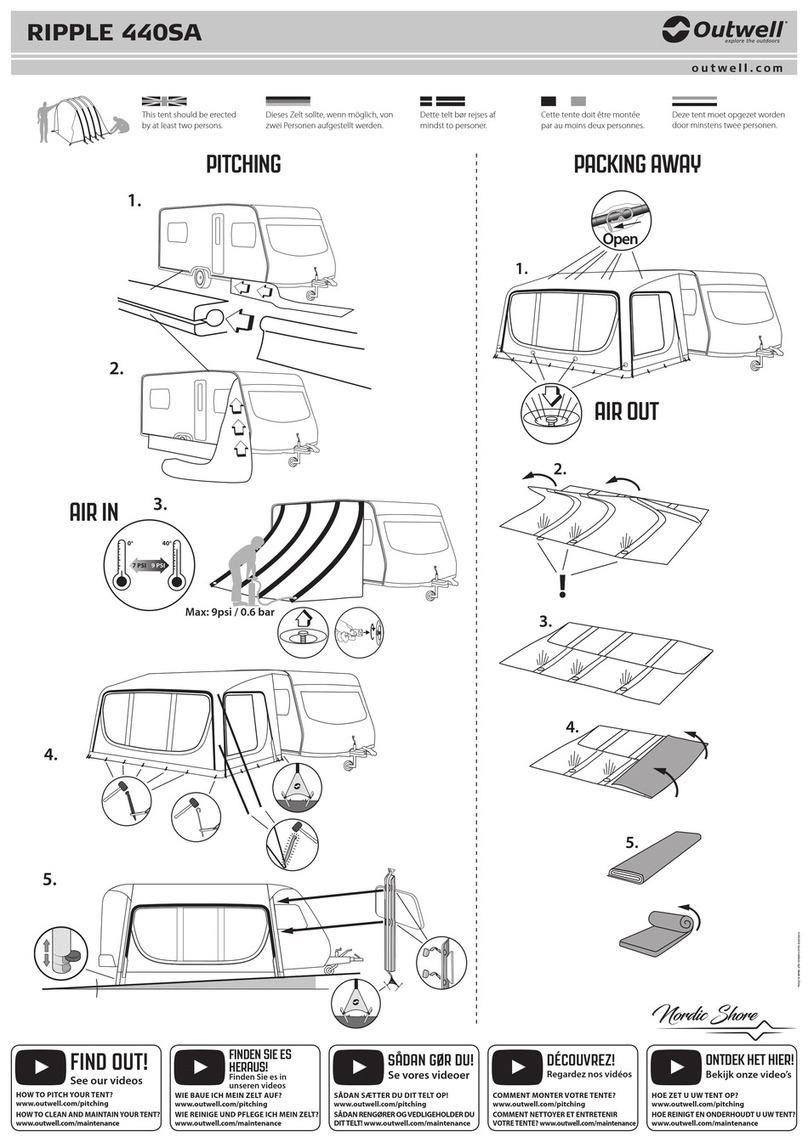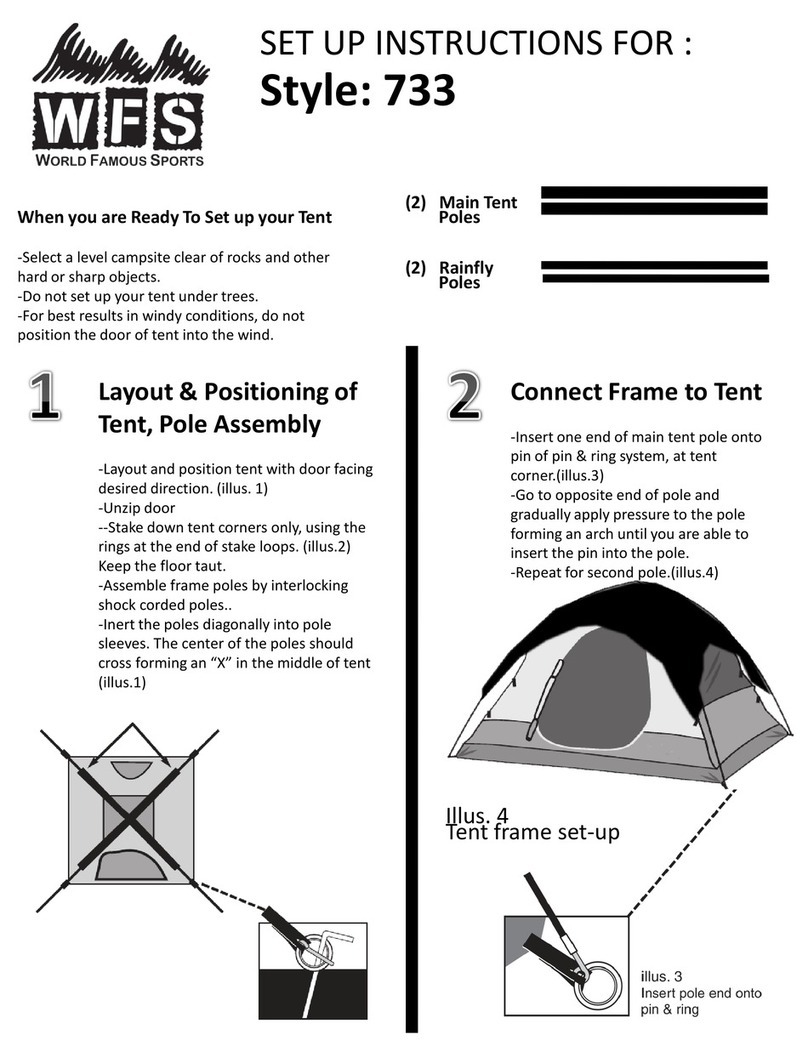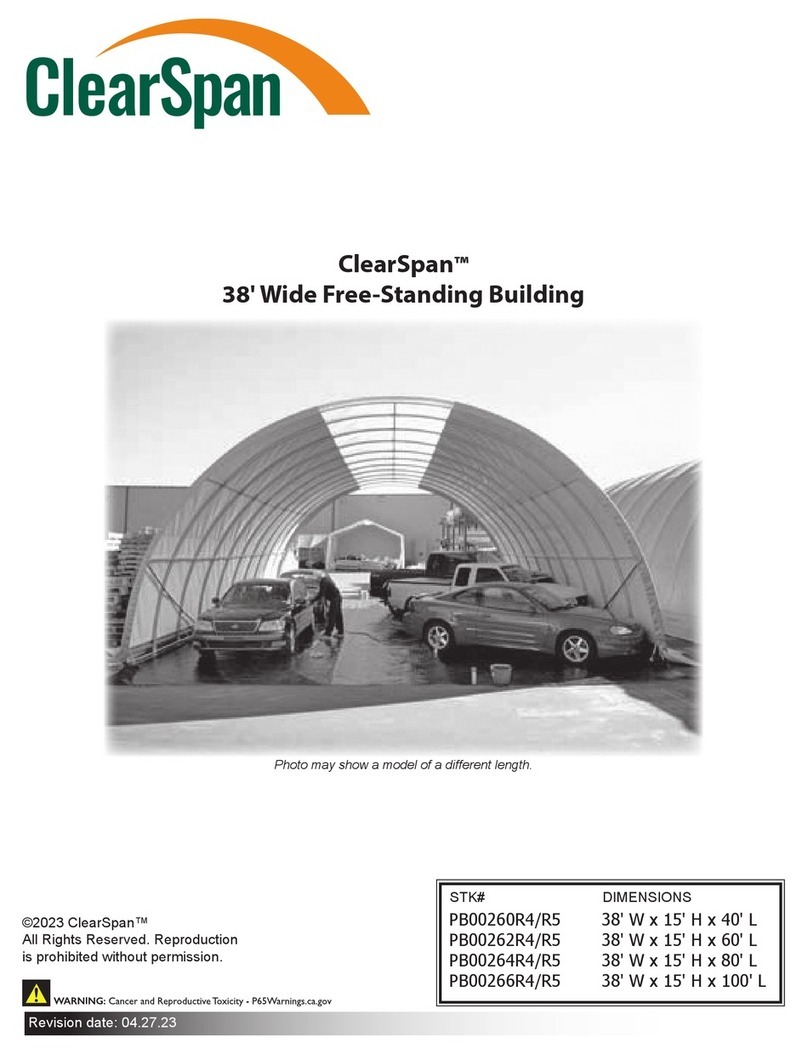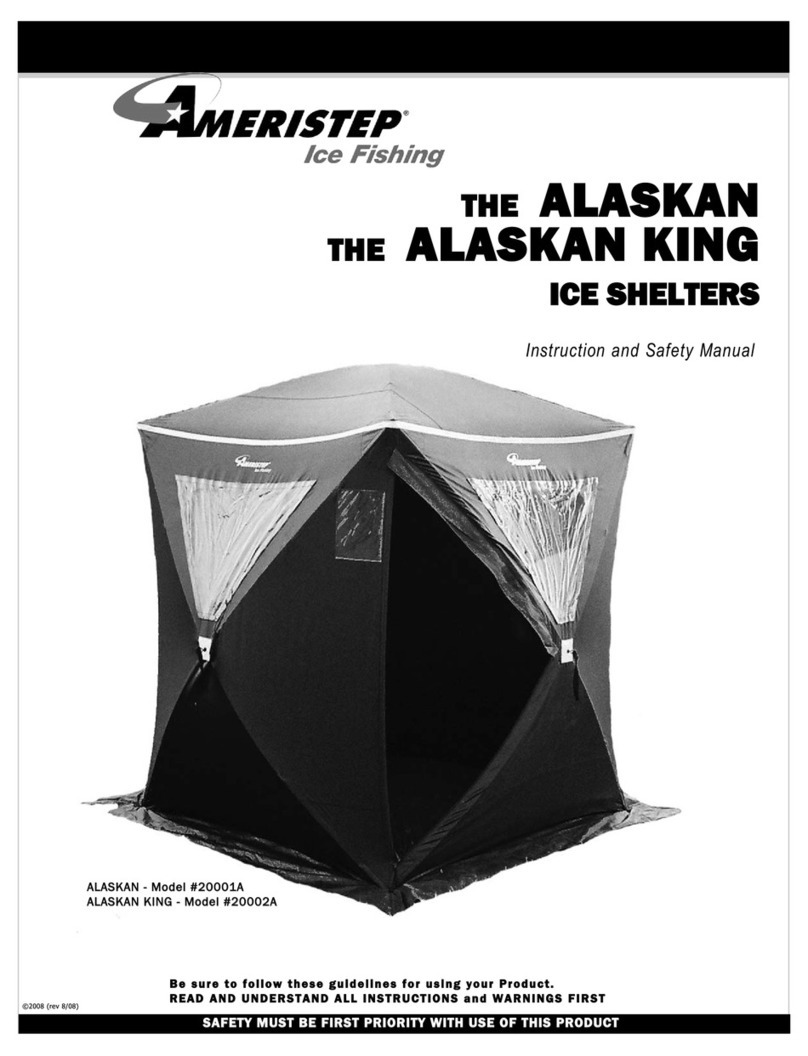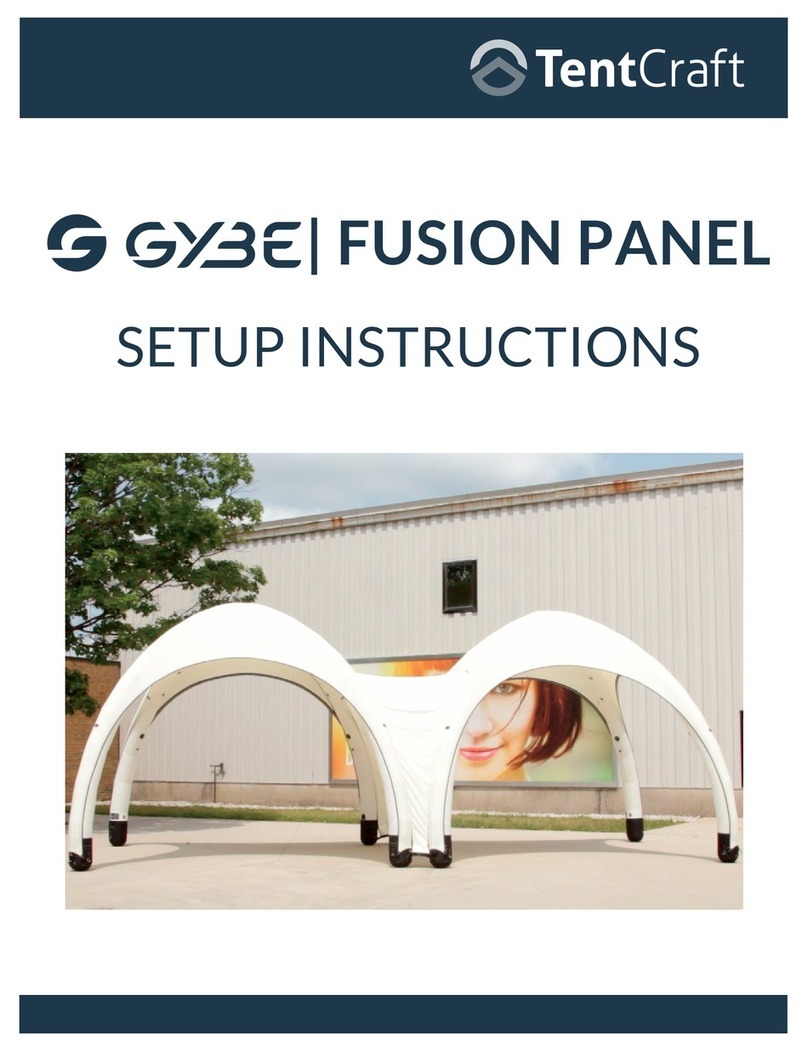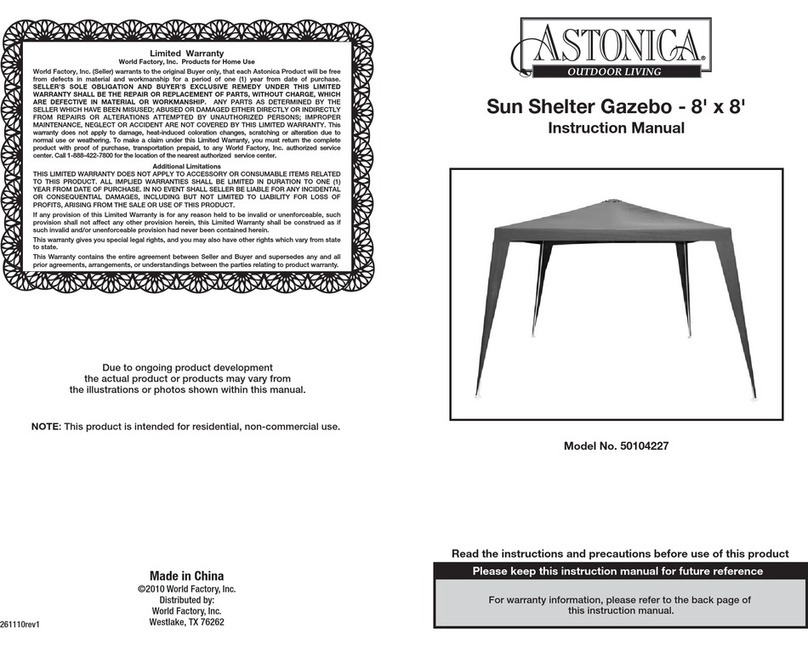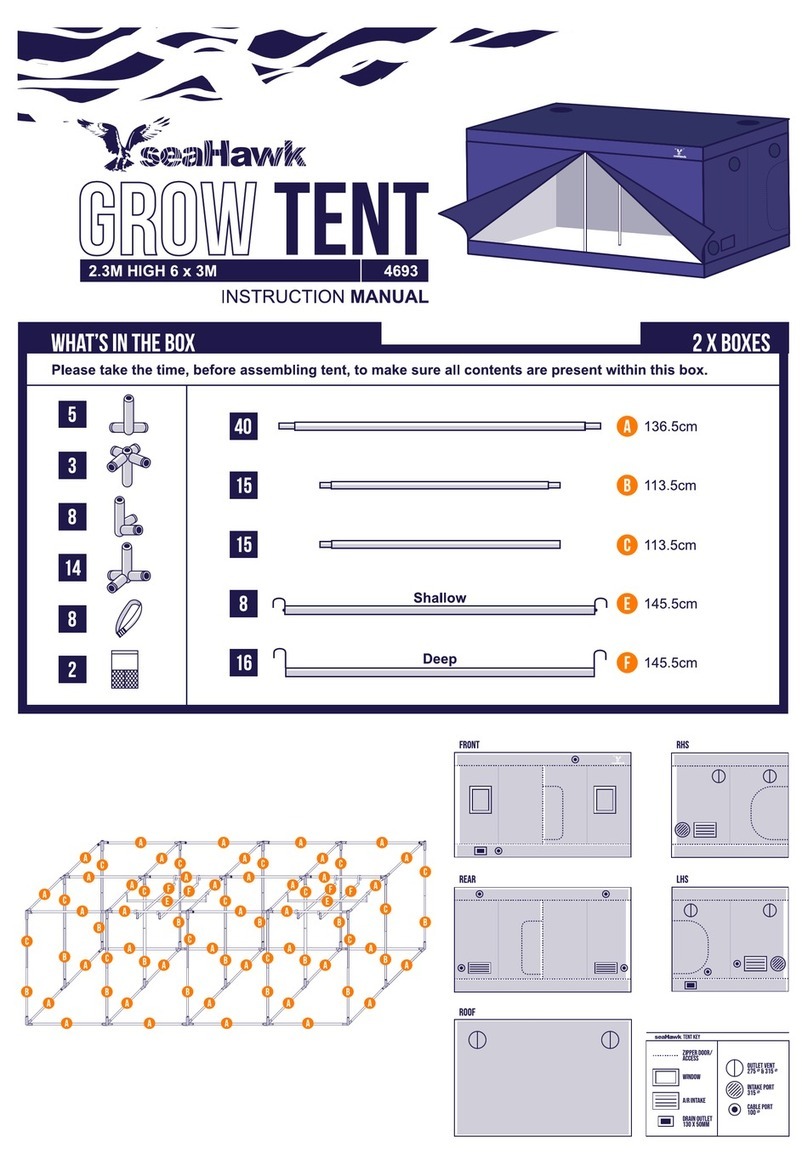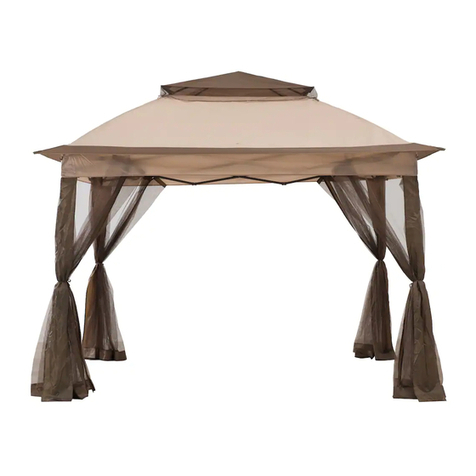fenek.shop Luxury Camping Tent 5m User manual

Page 1 / 16
Handbuch „Luxus Camping Zelt 5m“
Vielen Dank für den Erwerb unseres
hochwertigen Luxus Camping Zelt.
Sie finden beiliegend das Handbuch rund um
das 5M Baumwoll-Zelt. Bei Fragen stehen wir
Ihnen gerne zur Verfügung. Alle Kontaktdaten
finden Sie auf unserer Webseite unter
www.fenek.shop
Wir wünschen viel Spass mit dem Produkt.
Ihr Fenek.Shop-Team
Materialliste
1x Zeltdach aus Baumwoll-Canvas 300gsm
Mit 1 Zelteingang inkl. Mückenschutznetz und mit non-transparent
Abdeckung, 1 seitlicher Öffnungsschlitz für Stromkabel.
mit 4 Luftventilen inkl. Mückenschutznetz, mit 4 Fenster inkl.
Mückenschutznetz und mit non-transparent Abdeckung,
mit Ofen-Schornstein-Loch ca. Ø10.7cm inkl. Abdeckung
Alle erwähnten Mückenschutznetze sind mit 40gsm weiss ausgestattet
1x Grundblache aus PVC-Kunststoff 540gsm mit Ø5 Meter Grösse
1x grosse schwarze Tragetasche für den Transport
----------------------------------------------------------------------------------------------------------------------------------------------------
1x Stahlmittelstange Ø32mm mit 1.2mm Dicke in 3 Teilen verbunden
mit einem Stahl-Draht-Seil für die Mitte des Zeltes
(zusammengesteckt 3 Meter lang)
2x Stahlrohrstange Ø19mm mit 1.2mm Dicke inkl. Stahlrohrstangen-
Sack
1x gekrümmte Stahlrohrstange Ø19mm,1.2mm Dicke
(zusammenstecken für Zelteingang)
1x Kunststoff-Regenkappe für Zelteingang
----------------------------------------------------------------------------------------------------------------------------------------------------
12x Stahl-Heringe Ø5mm
13x Flachstahl-Heringe inkl. Heringe-Sack
9x Nylon-Schnur à ca. 2 Meter mit Kunststoff-Spanner
Bereits an Zeltdach befestigt
DE
EN
FR
IT

Page 2 / 16
Aufbauanleitung
Schritt 1) Nehmen Sie die PVC-Grundblache 540gsm und legen diese möglichst an einem ebenen erdigen
Untergrund aus. Achten Sie darauf, dass mindestens 1.5 Meter rundherum Platz für das Abspannen der
Seile besteht. Befestigen Sie mit den 12 Stk. Stahl-Heringe Ø5mm, anhand eines Gummihammers, an den
vorgesehen Ösen Lappen die PVC-Grundblache. Spannen Sie das Zelt nicht zu fest, da es sonst beim
Aufstellen zu Problemen führen kann.
Schritt 2) Legen Sie das Baumwoll-Canvas Zeltdach über die befestigte PVC-Grundblache. Richten Sie es
so aus, dass der Eingang des Zeltes sich am gewünschten Ort befindet. Achten Sie darauf, bevor Sie das
Zelt aufstellen, dass die Lüftungsventile beim Zeltspitz geöffnet arretiert sind. Stecken Sie nun die
Stahlmittelstange aus 3 Teilen zusammen und begeben Sie sich unter das Baumwoll-Canvas Zeltdach.
Drücken Sie mit der 3 Meter Stahlmittelstange das Zelt am Spitz des Zeltes hoch. Setzen Sie das andere
Ende der Stahlmittelstange auf die gekennzeichnete Stelle beim PVC-Grundblache ab. Verbinden Sie das
Baumwoll-Canvas Zeltdach mit der PVC-Grundblache mit den vorhergesehen Reisverschlüssen.
Schritt 3) Stecken Sie die 3 Komponenten des Zelteinganges zusammen (2x Stahlrohrstange + 1x
gekrümmte Stahlrohrstange) Stecken Sie den zusammengebauten Türbogen in die vorhergesehenen
Taschen, welche sich jeweils neben dem Zelteingang am Boden des PVC-Grundblache befinden. An der
Spitze des Türbogens befindet sich eine Spitze die durch die Öse oberhalb des Zelteinganges geführt
werden muss. Danach drücken Sie die Kunststoff-Regenkappe über die Spitze des Türbogens.
Schritt 4) Befestigen Sie, die an dem Zeltdach vorinstallierten Nylon-Schnüre, mit dem Flachstahl-Hering
inkl. Gummihammer in den erdigen Untergrund. Achten Sie darauf, dass die Schnur in einer geraden
Linie zur Schnur-Verbindung zum Zeltdach verläuft. Wenn Sie das Zelt zum ersten Mal aufstellen, ziehen
Sie das Zelt nicht zu fest an. Das Zelt benötigt einen einmaligen Einwitterungsprozess. Dieser Prozess wird
nachfolgend beschrieben.
DE
EN
FR
IT

Page 3 / 16
Einwitterungsprozess
Unsere neuen Baumwoll-Zelte können sich beim ersten Regen auf der Zeltinnenseite nass anfühlen. Das
ist völlig normal! Baumwollzelte müssen einen Einwitterungsprozess durchlaufen, um wasserdicht zu
werden. Es ist deshalb sehr wichtig, dass das Zelt beim ersten Aufstellen nicht zu stark gespannt ist, da
dies kontraproduktiv zum Einwitterungsprozess ist.
Wenn die Baumwolle nass wird, schrumpfen die Baumwollfasern in der Webung. Technisch dehnen sich
die Fasern aus, so dass die Lücken in der Webung schrumpfen. so wird der Vorgang auch als
„Schrumpfen“bezeichnet.
Die einzelnen Fasern fügen sich eng zusammen und schließen die winzigen Löcher in der Webung, so
dass der Baumwollstoff wasserdicht wird. So werden Zeltstoff und Nähte durch die Einwitterung
wasserdicht gemacht. Die kleinen Löcher in den Nähten
müssen sich um den Faden herum ausdehnen, um die
Nähte zu versiegeln (der Faden selbst dehnt sich auch
innerhalb des Lochs aus). Dieser Einwitterungsprozess
benötigt es in der Regel nur einmal. Sobald sich das Zelt
inwendig nicht mehr nass anfühlt, kann das Zelt stärker
gespannt werden.
Dann ist Ihr Zelt für jede Witterung in allen 4 Jahreszeiten
einsatzbereit.
Wichtige Informationen
Die Wartung beginnt beim Aufstellen Ihres Zeltes. Zelte die nicht richtig aufgebaut sind, ziehen
ungleichmäßige Kräfte an der Plane. Dies kann schließlich zu Beschädigungen führen. Um sicherzustellen,
dass Ihr Zelt täglich korrekt aufgestellt bleibt, ist Ein Nachspannen der Abspannseile notwendig. Um die
Wasserdichtigkeit Ihres Zeltes zu erhalten und die Lebensdauer nach längerem Gebrauch zu verlängern,
kann die Außenseite des Zeltes mit einer Versiegelung nachbehandelt werden. Es gibt viele gute
Sprühdosenversiegelungen auf dem Markt die dazu verwendet werden können.
Trocknen Sie Ihr Zelt immer, sofern möglich, bevor Sie es zum Lagern wegpacken. Lagern Sie das Zelt nie
länger als zwei Tage nass ein. Andernfalls können Pilze die Zeltplane befallen, die dann dauerhafte
Flecken verursachen.
Reißverschlüsse müssen manchmal extremen Spannungen standhalten, die durch Wind, falsches
Aufstellen des Zeltes oder Druck durch Personen oder Gegenstände, die sich in das Zelt lehnen,
verursacht werden. Um Schäden an den Reißverschlüssen zu vermeiden behandeln Sie die
Reißverschlüsse immer mit Sorgfalt. Schließen Sie alle Reißverschlüsse vor dem Aufstellen des Zeltes.
Schützen Sie die Reißverschlüsse, indem Sie sie ab und zu mit Silikon nachbehandeln.
Die Lebensdauer Ihres Zeltes ist stark abhängig von den Campingbedingungen wie Luftverschmutzung,
UV-Strahlung, natürlichem Schmutz (Vogelkot, Sand, Salzwasser) und häuslichem Schmutz (Kochflecken,
Soda, Wein, Sonnencreme). Unsere Zelte sind nicht für hoch extreme Witterungsbedingungen hergestellt,
unsere Garantie deckt keine Situationen ab, in denen sich Stangen infolge von Wind und Sturm verbogen
haben. Sollte dieser Fall tatsächlich eintreten, wenden Sie sich an Ihren Versicherungsanbieter.
Die Tragetasche mit allen Zeltkomponenten wiegt ca. 37 kg. Bitte mindestens zu Zweit anheben.
DE
EN
FR
IT

Page 4 / 16
Die Eigenschaften von Baumwolle (Zeltdach)
Baumwolle ist eine Naturfaser, die aus den Samenhaaren der Baumwollpflanze gewonnen wird.
Baumwolle hat einen grossen Vorteil gegenüber Zeltstoffen aus Synthetik Fasern: Baumwolle ist
atmungsaktiv. Das macht bei Hitze das Klima im Zelt äusserst angenehm. Aber auch bei kaltem Wetter ist
es im Baumwollzelt angenehm. Weil der Baumwollstoff vergleichsweise dick ist, isoliert er gut. Im Zelt ist
es spürbar wärmer als in Leichtgewicht-Zelten aus Kunstfaser. Bei feuchtem Wetter bildet sich an der
Innenseite des Zeltmaterials kein Kondenswasser. Deshalb haben Baumwollzelte kein Innenzelt –sie
brauchen es einfach nicht.
Als Naturfaser hat Baumwolle einen ausgezeichneten Schutz vor UV-Strahlung. Der Zeltstoff bleicht zwar
mit der Zeit aus. Anders als Kunstfasern wird er jedoch nicht spröde oder brüchig. Deshalb haben
Baumwollzelte eine besonders lange Lebensdauer.
Baumwollzelte trocknen nach einem Regenguss vergleichsweise langsam. Wenn Sie das Zelt im feuchten
Zustand verpacken, muss es spätestens nach einigen Tagen zum Trocknen ausgepackt werden. Ansonsten
bilden sich Stockflecken und Schimmel im Stoff, obwohl Baumwolle sehr schimmelbeständig ist. Um das
Schimmel-Risiko weiter zu minimieren, ist es wichtig, das Zelt sauber zu halten. Flecken und
Verschmutzung durch regelmässiges Säubern mit einer weichen Bürste und etwas Wasser wirken wunder.
Weil das Zeltmaterial so massiv ist, sind Baumwollzelte relativ teurer als übliche Kunststoffzelte. Dafür
kann dich ein Baumwollzelt sehr lange auf deinen Touren begleiten.
Ein letzter wichtiger Vorteil: das dicke Baumwolltuch raschelt bei Wind nicht. Das fördert einen
erholsamen Schlaf.
Die Baumwollqualität erkennt man durch das schwere Gewicht, welches mit gsm oder g/m² angegeben
wird. (Gramm pro Quadratmeter)
Leichter Baumwoll-Zeltstoff für kleine Zelte wiegen zwischen 120 –200 g/m²
Mittelschwerer Baumwoll-Zeltstoff für grosse Zelte wiegen zwischen 200 –260 g/m²
Schwere Baumwoll-Zeltstoffe für Gruppenzelte wiegen zwischen 200 –400 g/m²
Vorteile
•Baumwolle ist atmungsaktiv - es bildet sich kein Kondenswasser im Zelt
•Gute Isolation: Bei Hitze ist es im Zelt kühl, bei Kälte warm
•Hohe Lebensdauer dank natürlichem UV-Schutz
•Baumwolle raschelt nicht bei Wind und ist in allen 4 Jahreszeiten resistent
•Ein Baumwollzelt braucht kein Innenzelt
•Wasserdicht, flammhemmend, schimmelbeständig
Nachteile
•Baumwolle ist vergleichsweise schwer und hat ein großes Packmaß-Volumen
•Regelmäßige Pflege (Reinigen, Imprägnieren) erforderlich (erhöht stark die Lebensdauer)
•Hoher Preis im Vergleich zum Kunststoffzelt
DE
EN
FR
IT

Page 5 / 16
Manual „Luxury Camping Tent 5m“
Thank you for purchasing our high quality
luxury camping tent.
You will find enclosed the manual for the 5M
cotton tent. If you have any questions, please
do not hesitate to contact us. You will find all
contact details on our website at
www.fenek.shop.
We wish you a lot of fun with the product.
Your Fenek.Shop Team
List of materials
1x cotton canvas tent roof 300gsm
With 1 tent entrance incl. mosquito net and with non-transparent
cover, 1 side opening slot for power cable.
With 4 air valves incl. mosquito net, with 4 windows incl. mosquito
net and with non-transparent cover,
with stove chimney hole approx. Ø10.7cm incl. cover
All mentioned mosquito nets are equipped with 40gsm white
1x PVC ripstop plastic base sheet 540gsm with Ø5 meter size
1x large black carrying bag for transport
----------------------------------------------------------------------------------------------------------------------------------------------------
1x steel centre rod Ø32mm with 1.2mm thickness in 3 parts
connected with a steel-wire-rope for the middle of the tent
(assembled 3 meters long)
2x steel tube rod Ø19mm with 1.2mm thickness incl. steel tube rod
bag
1x curved steel tube rod Ø19mm, 1.2mm thickness (plug together for
tent entrance)
1x plastic rain cap for tent entrance
----------------------------------------------------------------------------------------------------------------------------------------------------
12x steel rings Ø5mm
13x flat steel pegs incl. peg bag
9x nylon cord approx. 2 metres each with plastic tensioner
Already attached to tent roof
DE
EN
FR
IT
Ø500 cm / height 300cm
10 adults / 12 children

Page 6 / 16
Assembly instructions
Step 1) Take the 540gsm PVC ground sheet and lay it out on a level, earthy surface if possible. Make sure
that there is at least 1.5 metres of space all around for tensioning the ropes. Use the 12 steel pegs Ø5mm
and a rubber mallet to attach the PVC ground sheet to the eyelets provided. Do not tension the tent too
tightly, otherwise it may cause problems when pitching.
Step 2) Place the cotton canvas tent roof over the attached PVC ground sheet. Align it so that the
entrance of the tent is in the desired location. Before erecting the tent, make sure that the ventilation
valves at the top of the tent are locked open. Now put the 3-piece steel centre pole together and go
under the cotton canvas tent roof. Use the 3-metre steel centre pole to push the tent up at the peak of
the tent. Place the other end of the steel centre pole on the marked spot by the PVC ground sheet.
Connect the cotton canvas tent roof to the PVC ground sheet using the zips provided.
Step 3) Put the 3 components of the tent entrance together (2x steel tube pole + 1x curved steel tube
pole). Put the assembled door arch into the pockets provided, which are located next to the tent
entrance at the bottom of the PVC ground sheet. At the top of the door arch there is a point which must
be passed through the eyelet above the tent entrance. Then press the plastic rain cap over the tip of the
door arch.
Step 4) Fasten the pre-installed nylon cords to the tent roof with the flat steel peg incl. rubber hammer
into the ground. Make sure that the cord runs in a straight line to the cord connection to the tent roof.
When setting up the tent for the first time, do not pull the tent too tight. The tent requires a one-time
weathering process. This process is described below.
DE
EN
FR
IT
1x Centre pole
1x Door arch
13x Guy ropes
Pegs & Stakes
1x Plastic rain cap
Ground
Zipper

Page 7 / 16
Weathering process
Our new cotton tents can feel wet on the inside of the tent when it first rains. This is completely normal!
Cotton tents have to go through a weathering process to become waterproof. It is therefore very
important that the tent is not stretched too much when first pitched, as this is counterproductive to the
weathering process.
When the cotton gets wet, the cotton fibres in the weave shrink. Technically, the fibres expand so that
the gaps in the weave shrink. so the process is also called "shrinking".
The individual fibres join closely together and close the tiny holes
in the weave, making the cotton fabric waterproof. This is how
tent fabric and seams are made waterproof by weathering. The
tiny holes in the seams need to expand around the thread to seal
the seams (the thread itself also expands inside the hole). This
weathering process usually only takes it once. Once the tent no
longer feels wet inside, the tent can be stretched more.
Then your tent is ready for any weather in all 4 seasons.
Important information
Maintenance begins when you set up your tent. Tents that are not set up properly pull uneven forces on
the canvas. This can eventually lead to damage. To ensure that your tent remains properly pitched on a
daily basis, re-tensioning of the guy ropes is necessary. To maintain the waterproofness of your tent and
extend its life after prolonged use, the outside of the tent can be refinished with a sealant. There are
many good spray can sealers on the market that can be used for this purpose.
Always dry your tent, if possible, before packing it away for storage. Never store the tent wet for more
than two days. Otherwise fungi can infest the tent canvas, causing permanent stains.
Zips sometimes have to withstand extreme stresses caused by wind, incorrect pitching of the tent or
pressure from people or objects leaning into the tent. To avoid damage to the zips, always handle the
zips with care. Close all zips before pitching the tent. Protect the zips by treating them with silicone from
time to time.
The life of your tent is highly dependent on camping conditions such as air pollution, UV radiation,
natural dirt (bird droppings, sand, salt water) and domestic dirt (cooking stains, soda, wine, sunscreen).
Our tents are not manufactured for highly extreme weather conditions, our warranty does not cover
situations where poles have bent as a result of wind and storm. If this does occur, please contact your
insurance provider.
The carrying bag with all tent components weighs approx. 37 kg. Please lift at least two people.
DE
EN
FR
IT

Page 8 / 16
The properties of cotton (tent roof)
Cotton is a natural fibre obtained from the seed hairs of the cotton plant. Cotton has a big advantage
over tent fabrics made from synthetic fibres: Cotton is breathable. This makes the climate in the tent
extremely pleasant in hot weather. But it is also pleasant in the cotton tent in cold weather. Because the
cotton fabric is comparatively thick, it insulates well. It is noticeably warmer inside the tent than in
lightweight tents made of synthetic fibre. In humid weather, no condensation the inside of the tent
material. That's why cotton tents don't have an inner tent - they simply don't need it.
As a natural fibre, cotton has excellent protection against UV radiation. The tent fabric does fade over
time. Unlike synthetic fibres, however, it does not become brittle or fragile. That is why cotton tents
have a particularly long life.
Cotton tents dry comparatively slowly after a downpour. If you pack the tent when it is damp, it must
be unpacked for drying after a few days at the latest. Otherwise mould stains and mildew will form in
the fabric, although cotton is very resistant to mildew. To further minimise the risk of mould, it is
important to keep the tent clean. Staining and soiling by cleaning regularly with a soft brush and a little
water works wonders.
Because the tent material is so solid, cotton tents are relatively more expensive than standard plastic
tents. On the other hand, a cotton tent can accompany you on your tours for a very long time.
A final important advantage: the thick cotton sheet does not rustle in the wind. This promotes a restful
sleep.
The cotton quality can be recognised by the heavy weight, which is indicated with gsm or g/m². (gram
per square metre)
Lightweight cotton tent fabric for small tents weigh between 120 - 200 g/m².
Medium-weight cotton tent fabric for large tents weighs between 200 - 260 g/m².
Heavy-weight cotton tent fabric for large tents weighs between 200 –400 g/m²
Advantages
•Cotton is breathable - no condensation forms in the tent.
•Good insulation: the tent is cool in the heat and warm in the cold
•Long life thanks to natural UV protection
•Cotton does not rustle in the wind and is resistant in all 4 seasons.
•A cotton tent does not need an inner tent
•Waterproof, flame retardant, mould resistant
Disadvantages
•Cotton is comparatively heavy and has a large pack size volume.
•Regular care (cleaning, impregnation) required (greatly increases life span)
•High price compared to a plastic tent
DE
EN
FR
IT

Page 9 / 16
Manuel "Tente de camping de luxe 5m“
Merci d'avoir acheté notre tente de camping
de luxe de haute qualité.
Vous trouverez ci-joint le manuel autour de la
tente en coton 5M. Si vous avez des questions,
n'hésitez pas à nous contacter. Vous trouverez
toutes les coordonnées sur notre site web à
l'adresse www.fenek.shop.
Nous vous souhaitons beaucoup de plaisir avec
ce produit.
Votre équipe Fenek.Shop
Liste des matériaux
1x toit de tente en toile de coton 300gsm
Avec 1 entrée de tente avec moustiquaire et couvercle non
transparent, 1 ouverture latérale pour le câble d'alimentation.
Avec 4 valves d'air incluses dans la moustiquaire, avec 4 fenêtres
incluses dans la moustiquaire et avec une couverture non
transparente,
avec trou de cheminée du poêle d'environ Ø10,7cm, couvercle inclus
Toutes les moustiquaires mentionnées sont équipées de 40gsm blanc
1x feuille de base en plastique PVC 540gsm avec une taille de Ø5
mètres
1x grand sac noir pour le transport
----------------------------------------------------------------------------------------------------------------------------------------------------
1x tige centrale en acier Ø32mm de 1,2 mm d'épaisseur en 3 parties
reliées par un câble en acier pour le milieu de la tente
(assemblé à 3 mètres de long)
2x tige en tube d'acier Ø19mm, avec une épaisseur de 1,2 mm, y
compris le sac de tiges d'acier
1x tige en tube d'acier courbé Ø19mm, 1,2 mm d'épaisseur
(s'emboîtent pour l'entrée de la tente)
1x capuchon de pluie en plastique pour l'entrée de la tente
----------------------------------------------------------------------------------------------------------------------------------------------------
12x anneaux en acier Ø5mm
13x chevilles plates en acier sac de chevilles inclus
9x cordon en nylon à environ 2 mètres avec un tendeur en plastique
Déjà fixé au toit de la tente
DE
EN
FR
IT
Ø500 cm / hauteur 300cm
110 adultes / 12 enfants

Page 10 / 16
Instructions de montage
Étape 1) Prenez la feuille de base en PVC 540gsm et disposez-la sur une surface plane et terreuse si
possible. Assurez-vous qu'il y a au moins 1,5 mètre d'espace tout autour pour tendre les cordes. Fixez la
bâche de sol en PVC à l'aide des 12 piquets en acier Ø5mm, en utilisant un marteau en caoutchouc, aux
œillets prévus à cet effet. Ne tendez pas trop la tente, sinon cela peut poser des problèmes lors du
montage.
Étape 2) Prenez la feuille de base en PVC 540gsm et disposez-la sur une surface plane et terreuse si
possible. Assurez-vous qu'il y a au moins 1,5 mètre d'espace tout autour pour tendre les cordes. Fixez la
bâche de sol en PVC à l'aide des 12 piquets en acier Ø5mm, en utilisant un marteau en caoutchouc, aux
œillets prévus à cet effet. Ne tendez pas trop la tente, sinon cela peut poser des problèmes lors du
montage.
Étape 3) Assemblez les 3 composants de l'entrée de la tente (2x poteau tubulaire en acier + 1x poteau
tubulaire en acier courbé). Insérez l'arc de porte assemblé dans les poches prévues à cet effet, qui se
trouvent à côté de l'entrée de la tente, au bas du tapis de sol en PVC. En haut de l'arc de la porte se
trouve une pointe qui doit être passée dans l'œillet situé au-dessus de l'entrée de la tente. Appuyez
ensuite le capuchon de pluie en plastique sur l'extrémité de l'arc de la porte.
Étape 4) Fixez les cordes en nylon préinstallées au toit de la tente à l'aide de la cheville plate en acier, y
compris le marteau en caoutchouc dans le sol. Veillez à ce que le cordon soit en ligne droite jusqu'à la
connexion du cordon au toit de la tente. Lorsque vous montez la tente pour la première fois, ne serrez
pas trop la tente. La tente nécessite un processus d'altération unique. Ce processus est décrit ci-dessous.
DE
EN
FR
IT
1x Pôle central
1x Arc de porte
13x Cordes à
gars
Chevilles et
piquets
1x Capuchon
de pluie en
plastique
Le terrain
Fermeture éclair

Page 11 / 16
Processus d'altération
Nos nouvelles tentes en coton peuvent sembler humides à l'intérieur de la tente lors de la première
pluie. C'est tout à fait normal ! Les tentes en coton doivent passer par un processus de vieillissement pour
devenir imperméables. Il est donc très important que la tente ne soit pas trop tendue lors du premier
montage, car cela va à l'encontre du processus de vieillissement.
Lorsque le coton est mouillé, les fibres de coton du tissage se rétractent. Techniquement, les fibres se
dilatent de manière à ce que les interstices du tissage se rétrécissent. Le processus est donc également
appelé "rétrécissement".
Les fibres individuelles s'emboîtent étroitement et ferment les minuscules trous du tissage, ce qui rend le
tissu de coton imperméable. C'est ainsi que le tissu et les coutures
de la tente sont rendus imperméables par les intempéries. Les
minuscules trous dans les coutures doivent se dilater autour du fil
pour sceller les coutures (le fil lui-même se dilate également dans
le trou). Ce processus d'altération ne se produit généralement
qu'une seule fois. Une fois que la tente n'est plus humide à
l'intérieur, elle peut être étirée davantage.
Votre tente est alors prête à affronter n'importe quel temps
pendant les 4 saisons.
Informations importantes
L'entretien commence lorsque vous montez votre tente. Les tentes qui ne sont pas montées correctement
exercent des forces inégales sur la bâche. Cela peut éventuellement entraîner des dommages. Pour
garantir que votre tente reste correctement montée au quotidien, il est nécessaire de retendre les cordes
d’haubanage. Pour préserver l'étanchéité de votre tente et prolonger sa durée de vie après une utilisation
prolongée, l'extérieur de la tente peut être retouché avec un produit d'étanchéité. Il existe sur le marché
de nombreux bons mastics en bombe qui peuvent être utilisés à cette fin.
Faites toujours sécher votre tente, si possible, avant de la ranger. Ne stockez jamais la tente humide
pendant plus de deux jours. Sinon, des champignons peuvent infester la toile de tente et provoquer des
taches permanentes.
Les fermetures à glissière doivent parfois résister à des contraintes extrêmes dues au vent, à un mauvais
positionnement de la tente ou à la pression exercée par des personnes ou des objets qui s'appuient sur la
tente. Pour éviter d'endommager les fermetures à glissière, manipulez-les toujours avec précaution.
Fermez toutes les fermetures éclair avant de monter la tente. Protégez les fermetures éclair en les traitant
de temps en temps avec du silicone.
La durée de vie de votre tente dépend fortement des conditions de camping telles que la pollution
atmosphérique, les rayons UV, les salissures naturelles (fientes d'oiseaux, sable, eau salée) et les salissures
domestiques (taches de cuisine, soda, vin, crème solaire). Nos tentes ne sont pas fabriquées pour des
conditions météorologiques très extrêmes, notre garantie ne couvre pas les situations où les poteaux ont
plié à cause du vent et des tempêtes. Si cela se produit, contactez votre assureur.
Le sac de transport avec tous les éléments de la tente pèse environ 37 kg. Veuillez soulever au moins
deux personnes.
DE
EN
FR
IT

Page 12 / 16
Les propriétés du coton (toit de la tente)
Le coton est une fibre naturelle obtenue à partir des poils des graines du cotonnier. Le coton présente un
grand avantage par rapport aux tissus de tente fabriqués à partir de fibres synthétiques: Le coton est
respirant. Cela rend le climat dans la tente extrêmement agréable par temps chaud. Mais même par
temps froid, il est agréable d'être dans la tente en coton. Parce que le tissu en coton est relativement
épais, il isole bien. Il fait sensiblement plus chaud à l'intérieur de la tente que dans les tentes légères en
fibre synthétique. Par temps humide, la condensation ne se forme pas à l'intérieur de la toile de tente.
C'est pourquoi les tentes en coton n'ont pas de tente intérieure - elles n'en ont tout simplement pas
besoin.
En tant que fibre naturelle, le coton offre une excellente protection contre les rayons UV. Le tissu de la
tente se décolore avec le temps. Toutefois, contrairement aux fibres synthétiques, il ne devient pas
cassant ou fragile. C'est pourquoi les tentes en coton ont une durée de vie particulièrement longue.
Les tentes en coton sèchent relativement lentement après une averse. Si vous emballez la tente lorsqu'elle
est humide, il faut la déballer pour la faire sécher au plus tard après quelques jours. Sinon, des taches de
mildiou et des moisissures se formeront dans le tissu, même si le coton est très résistant aux moisissures.
Pour minimiser davantage le risque de moisissure, il est important de garder la tente propre. Les taches et
la saleté en nettoyant régulièrement avec une brosse douce et un peu d'eau font des merveilles.
Comme le matériau de la tente est très solide, les tentes en coton sont relativement plus chères que les
tentes en plastique standard. Mais une tente en coton peut vous accompagner pendant très longtemps
dans vos excursions.
Un dernier avantage important : l'épaisse toile de coton ne bruisse pas dans le vent. Cela favorise un
sommeil réparateur. La qualité du coton se reconnaît au poids important, qui est indiqué par gsm ou
g/m². (gramme par mètre carré)
Tissu de tente en coton léger pour les petites tentes, pesant entre 120 et 200 g/m².
La toile de tente en coton de poids moyen pour les grandes tentes pèse entre 200 et 260 g/m².
Les toiles de tente en coton lourd pour les tentes de groupe pèsent entre 200 –400 g/m².
Avantages
•Le coton est respirant - aucune condensation ne se forme dans la tente.
•Bonne isolation : la tente est fraîche par temps chaud et chaude par temps froid.
•Longue durée de vie grâce à la protection naturelle contre les UV
•Le coton ne bruisse pas au vent et résiste aux 4 saisons.
•Une tente en coton n'a pas besoin d'une tente intérieure
•Imperméable, ignifuge, résistant à la moisissure.
Inconvénients
•Le coton est relativement lourd et son volume d'emballage est important.
•Entretien régulier (nettoyage, imprégnation) nécessaire (augmente considérablement la durée de vie)
•Prix élevé par rapport à une tente synthétique
DE
EN
FR
IT

Page 13 / 16
Manuale "Tenda da campeggio di lusso 5m“
Grazie per aver acquistato la nostra tenda da
campeggio di lusso di alta qualità.
Troverete allegato il manuale intorno alla
tenda di cotone 5M. Se avete domande, non
esitate a contattarci. Troverete tutti i dettagli di
contatto sul nostro sito web all'indirizzo
www.fenek.shop
Vi auguriamo un sacco di divertimento con il
prodotto.
Il tuo team Fenek.Shop
Elenco dei materiali
1x tetto della tenda in tela di cotone 300gsm
Con 1 ingresso tenda incl. zanzariera e con copertura non
trasparente, 1 fessura di apertura laterale per il cavo di alimentazione.
Con 4 valvole d'aria incl. zanzariera, con 4 finestre incl. zanzariera e
con copertura non trasparente,
con foro per il camino della stufa ca. Ø10,7cm incluso il coperchio
Tutte le zanzariere menzionate sono dotate di 40gsm bianco
1x foglio base in plastica PVC 540gsm con dimensioni di Ø5 metri
1x grande borsa nera per il trasporto
----------------------------------------------------------------------------------------------------------------------------------------------------
1x asta centrale in acciaio Ø32mm con uno spessore di 1,2 mm in 3
parti collegate con una fune d'acciaio per il centro della tenda
(assemblato lungo 3 metri)
2x asta di tubo d'acciaio Ø19mm con spessore di 1,2 mm, compresa
la borsa di tondino d'acciaio
1x tubo d'acciaio curvo Ø19mm, 1.2mm di spessore (spina insieme
per l'ingresso della tenda)
1x tappo di plastica per la pioggia per l'ingresso della tenda
----------------------------------------------------------------------------------------------------------------------------------------------------
12x anelli d'acciaio Ø5mm
13x pioli in acciaio piatto con borsa per pioli
9x corda di nylon à circa 2 metri con tenditore in plastica
Già attaccato al tetto della tenda
DE
EN
FR
IT
Ø500 cm / altezza 300cm
10 adulti / 12 bambini

Page 14 / 16
Istruzioni per il montaggio
Passo 1) Prendete il foglio di base in PVC 540gsm e stendetelo su una superficie piana e terrosa, se
possibile. Assicuratevi che ci sia almeno 1,5 metri di spazio tutto intorno per mettere in tensione le corde.
Fissare il telo di terra in PVC con i 12 pioli in acciaio Ø5mm, utilizzando un martello di gomma, agli
occhielli forniti. Non tendere troppo la tenda, altrimenti potrebbe causare problemi durante il
montaggio.
Passo 2) Posizionare il tetto della tenda in tela di cotone sopra il telo di terra in PVC attaccato. Allinearlo
in modo che l'ingresso della tenda sia nella posizione desiderata. Prima di montare la tenda, assicurati
che le valvole di ventilazione del picco della tenda siano bloccate. Ora metti il palo centrale d'acciaio di
3 pezzi insieme e vai sotto il tetto della tenda di cotone. Utilizzare il palo centrale in acciaio di 3 metri
per spingere la tenda verso l'alto sulla punta della tenda. Posizionare l'altra estremità del palo centrale in
acciaio sul punto segnato dal foglio di terra in PVC. Collegare il tetto della tenda in tela di cotone al telo
di terra in PVC utilizzando le cerniere fornite.
Passo 3) Assemblare i 3 componenti dell'ingresso della tenda (2x palo in acciaio tubolare + 1x palo in
acciaio tubolare curvo). Inserire l'arco della porta assemblato nelle apposite tasche, che si trovano
accanto all'ingresso della tenda nella parte inferiore del telo in PVC. In cima all'arco della porta c'è un
punto che deve passare attraverso l'occhiello sopra l'ingresso della tenda. Poi premi il tappo di plastica
per la pioggia sulla punta dell'arco della porta.
Passo 4) Fissare le corde di nylon preinstallate al tetto della tenda con il picchetto d'acciaio piatto incluso
il martello di gomma nel terreno. Assicuratevi che il cavo scorra in linea retta fino alla connessione del
cavo al tetto della tenda. Quando si monta la tenda per la prima volta, non stringere troppo la tenda.
La tenda richiede un processo di invecchiamento una tantum. Questo processo è descritto di seguito.
DE
EN
FR
IT
1x Polo centrale
1x Arco della
porta
13x Corde da
uomo
Pioli e picchetti
Tappo di
plastica per la
pioggia
Il terreno
Cerniera

Page 15 / 16
Processo di Weathering
Le nostre nuove tende di cotone possono sentirsi bagnate all'interno della tenda quando piove per la
prima volta. Questo è completamente normale! Le tende di cotone devono passare attraverso un
processo di invecchiamento per diventare impermeabili. È quindi molto importante che la tenda non sia
troppo tesa quando viene piantata per la prima volta, perché questo è controproducente per il processo
di invecchiamento.
Quando il cotone si bagna, le fibre di cotone nella trama si restringono. Tecnicamente, le fibre si
espandono in modo che gli spazi nella trama si restringono. quindi il processo è anche chiamato
"restringimento".
Le singole fibre si adattano strettamente l'una all'altra e chiudono i
piccoli fori nella trama, rendendo il tessuto di cotone
impermeabile. È così che il tessuto della tenda e le cuciture sono
resi impermeabili dagli agenti atmosferici. I piccoli fori nelle
cuciture devono espandersi intorno al filo per sigillare le cuciture
(il filo stesso si espande anche all'interno del foro). Questo
processo d'invecchiamento di solito avviene solo una volta.
Quando la tenda non si sente più bagnata all'interno, si può
allungare di più.
Allora la vostra tenda è pronta per qualsiasi tempo in tutte e 4 le stagioni.
Informazioni importanti
La manutenzione inizia quando si monta la tenda. Le tende che non sono montate correttamente tirano
forze irregolari sul telo. Questo può alla fine portare a dei danni. Per assicurarsi che la tenda rimanga
correttamente montata ogni giorno, è necessario ritensionare le corde di ancoraggio. Per mantenere
l'impermeabilità della tenda e prolungarne la vita dopo un uso prolungato, l'esterno della tenda può
essere rifinito con un sigillante. Ci sono molti buoni sigillanti per bombolette spray sul mercato che
possono essere usati per questo scopo.
Asciugare sempre la tenda, se possibile, prima di imballarla per riporla. Non conservare mai la tenda
bagnata per più di due giorni. Altrimenti, i funghi possono infestare il telo della tenda, causando macchie
permanenti.
Le cerniere a volte devono resistere a sollecitazioni estreme causate dal vento, dall'errato montaggio
della tenda o dalla pressione di persone o oggetti appoggiati alla tenda. Per evitare danni alle cerniere,
maneggiarle sempre con cura. Chiudere tutte le cerniere prima di montare la tenda. Proteggete le
cerniere trattandole di tanto in tanto con del silicone.
La vita della vostra tenda dipende molto dalle condizioni di campeggio come l'inquinamento dell'aria, i
raggi UV, lo sporco naturale (escrementi di uccelli, sabbia, acqua salata) e lo sporco domestico (macchie
di cucina, soda, vino, crema solare). Le nostre tende non sono fabbricate per condizioni climatiche molto
estreme, la nostra garanzia non copre situazioni in cui i pali si sono piegati a causa del vento e delle
tempeste. Se questo accade, contattate il vostro assicuratore.
La borsa di trasporto con tutti i componenti della tenda pesa circa 37 kg. Si prega di sollevare almeno
due persone.
DE
EN
FR
IT

Page 16 / 16
Le proprietà del cotone (tetto della tenda)
Il cotone è una fibra naturale ottenuta dai peli dei semi della pianta del cotone. Il cotone ha un grande
vantaggio rispetto ai tessuti per tende in fibre sintetiche: Il cotone è traspirante. Questo rende il clima
nella tenda estremamente piacevole nella stagione calda. Ma anche nella stagione fredda è piacevole
nella tenda di cotone. Perché il tessuto di cotone è relativamente spesso, isola bene. All'interno della
tenda è sensibilmente più caldo che nelle tende leggere in fibra sintetica. Con tempo umido, la condensa
non si forma all'interno del materiale della tenda. Ecco perché le tende di cotone non hanno una tenda
interna - semplicemente non ne hanno bisogno.
Come fibra naturale, il cotone ha un'eccellente protezione contro i raggi UV. Il tessuto della tenda
sbiadisce col tempo. A differenza delle fibre sintetiche, tuttavia, non diventa fragile e friabile. Ecco
perché le tende di cotone hanno una durata particolarmente lunga.
Le tende di cotone si asciugano relativamente lentamente dopo un acquazzone. Se imballate la tenda
quando è umida, deve essere disimballata per asciugarla al più tardi dopo qualche giorno. Altrimenti si
formeranno macchie di muffa e muffa nel tessuto, anche se il cotone è molto resistente alla muffa. Per
minimizzare ulteriormente il rischio di muffa, è importante mantenere la tenda pulita. Macchie e sporco
pulendo regolarmente con una spazzola morbida e un po' d'acqua fa miracoli.
Poiché il materiale della tenda è così solido, le tende di cotone sono relativamente più costose delle
tende di plastica standard. Ma una tenda di cotone può accompagnarvi nei vostri tour per molto tempo.
Un ultimo importante vantaggio: la spessa tela di cotone non fruscia al vento. Questo favorisce un
sonno riposante. La qualità del cotone si riconosce dalla pesantezza, che è indicata con gsm o g/m².
(grammo per metro quadrato)
Il tessuto di cotone leggero per tende piccole pesa tra i 120 e i 200 g/m².
Il tessuto di cotone di medio peso per tende grandi pesa tra 200 e 260 g/m².
I tessuti di cotone pesante per tende di gruppo pesano tra 200 –400 g/m²
Vantaggi
•Il cotone è traspirante - non si forma condensa nella tenda
•Buon isolamento: la tenda è fresca quando fa caldo e calda quando fa freddo
•Lunga durata grazie alla protezione UV naturale
•Il cotone non fruscia al vento ed è resistente in tutte e 4 le stagioni.
•Una tenda di cotone non ha bisogno di una tenda interna
•Impermeabile, ignifugo, resistente alle muffe
Svantaggi
•Il cotone è relativamente pesante e ha un grande volume di imballaggio
•È necessaria una cura regolare (pulizia, impregnazione) (aumenta notevolmente la durata di vita)
•Prezzo elevato rispetto a una tenda sintetica
DE
EN
FR
IT
Table of contents
Languages:
Popular Tent manuals by other brands
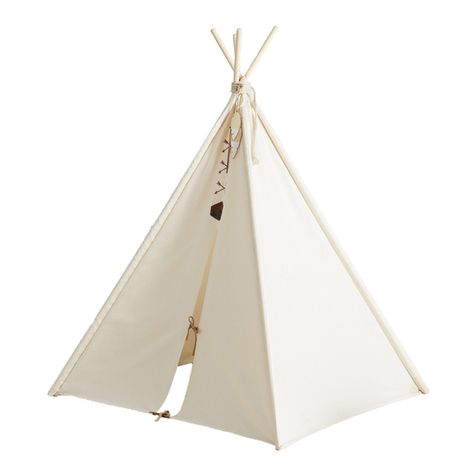
Asweets
Asweets Wonder & Wise EVERYDAY TEEPEE Assembly instructions

Jack Wolfskin
Jack Wolfskin TRAVEL LODGE RT Assembly instructions
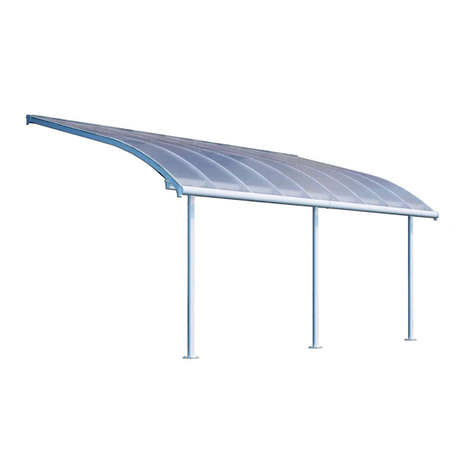
Palram
Palram Joya 3x5.46 instructions

Schou
Schou Outfit 624119 instruction manual
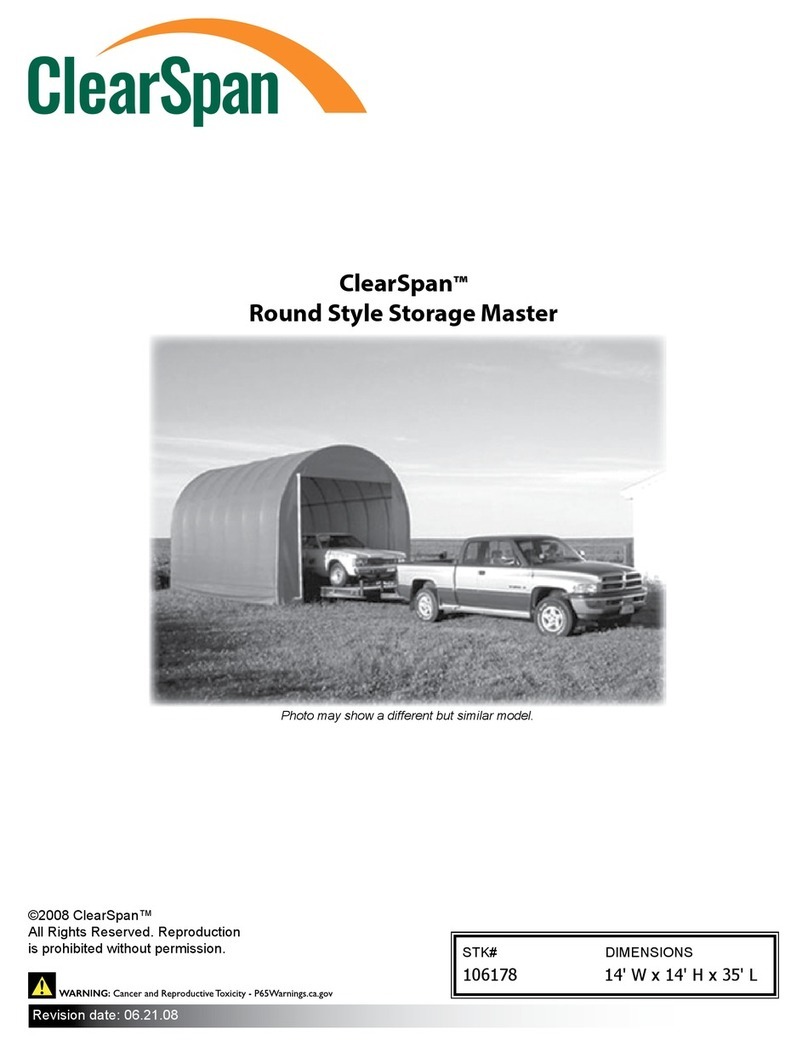
ClearSpan
ClearSpan Value Line 106178 Assembly instructions

Outdoor Revolution
Outdoor Revolution Movelite Oxygen 3 quick start guide
